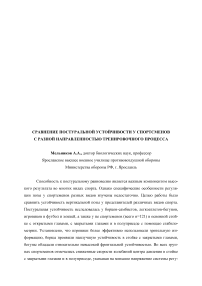Сравнение постуральной устойчивости у спортсменов с разной направленностью тренировочного процесса
Автор: Мельников А.А.
Журнал: Физическое воспитание и спортивная тренировка @journal-fvist
Рубрика: Медико-биологические аспекты физического воспитания и спортивной тренировки
Статья в выпуске: 2 (28), 2019 года.
Бесплатный доступ
Способность к постуральному равновесию является важным компонентом высокого результата во многих видах спорта. Однако специфические особенности регуляции позы у спортсменов разных видов изучены недостаточно. Целью работы было сравнить устойчивость вертикальной позы у представителей различных видов спорта. Постуральная устойчивость исследовалась у борцов-самбистов, легкоатлетов-бегунов, игровиков в футбол и хоккей, а также у не спортсменов (всего n=121) в основной стойке с открытыми глазами, с закрытыми глазами и в полуприседе c помощью стабилометрии. Установлено, что игровики более эффективно использовали зрительную информацию, борцы проявили наилучшую устойчивость в стойке с закрытыми глазами, бегуны обладали относительно невысокой фронтальной устойчивостью. Во всех группах спортсменов отмечались сниженные скорости колебаний центра давления в стойке с закрытыми глазами и в полуприседе, указывая на меньшее напряжение системы регуляции позы. Выявленные особенности постуральной регуляции у спортсменов, вероятно, связаны со спецификой спортивной деятельности.
Постуральный баланс, стабилометрия, спортсмены разной направленности
Короткий адрес: https://sciup.org/140243709
IDR: 140243709
Список литературы Сравнение постуральной устойчивости у спортсменов с разной направленностью тренировочного процесса
- Age-related relative increases in electromyography activity and torque according to the maximal capacity during upright standing / Billot M. [et al.] // Eur. J. Appl. Physiol. - 2010. - V. 109. - P. 669-680.
- Asseman F.B., Caron O., Crémieux J. Are there specific conditions for which expertise in gymnastics could have an effect on postural control and performance? // J. Gait Posture. - 2008. - V. 27. - P. 76-81
- Comparison of Static and Dynamic Balance in Female Collegiate Soccer, Basketball, and Gymnastics Athletes / Bressel E. [et al.] //J. Athletic Training. - 2007. - V. 42. - P. 42-46.
- Comparison of static balance and the role of vision in elite athletes / Hammami R. [et al.] //J. Hum. Kinet. - 2014. - V. 8. - P. 33-41.
- Era P., Konttinen N., Mehto P. Postural stability and skilled performance-a study on top level and naive rifle shooters //J. Biomech. - 1996. - V. 29. - P. 301-306.
- Hrysomallis C. Balance ability and athletic performance//Sports Med. 2011. -V. 41. -№ 3. -Р. 221-232.
- Judo, better than dance, develops sensorimotor adaptabilities involved in balance control/Perrin P. //Gait Posture. -2002. -V. 15. -P. 187-194
- Kuczyński M., Rektor Z., Borzucka D. Postural Control in Quiet Stance in the Second League Male Volleyball Players//Human Movement. -2009. -V. 10. -P. 12-15.
- Massion J. Postural control system//Curr. Opin. Neurobiol. -1994. -V. 4. -P. 877-887.
- Matsuda S., Demura S., Uchiyama M. Centre of pressure sway characteristics during static one-legged stance of athletes from different sports//J. Sports Sciences. -2008. -V. 26. -P. 775-779.
- Murphy, D. F. Connolly D.A.J., Beynnon B.D. Risk factors for lower extremity injury: a review of the literature//Br. J. Sports. Med. -2003. -V. 37. -P. 13-29.
- Perrot C., Deviterne D., Perrin P. Influence of training on postural and motor control in a combative sport//J. Hum. Mov. Studies. -1998. -V. 35. -P. 119-135.
- Postural control in athletes participating in an ironman triathlon/Nagy E. //Eur. J. Appl. Physiol. -2004. -V. 92. -P. 407-413.
- Postural performance and strategy in the unipedal stance of soccer players at different levels of competition/Paillard T. //J. Athl. Train. -2006. -V. 41. -P. 172-176.
- Vuillerme N., Nougier V. Attentional demand for regulating postural sway: the effect of expertise in gymnastics//Brain Research. Bulletin. -2004. -V. 63. -P. 161-165.


